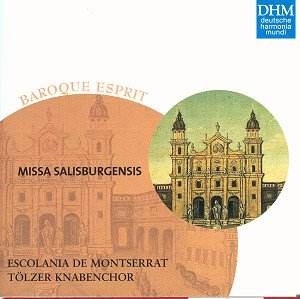Thirty years or more ago, as I was beginning to study
music seriously, I went through the rebellion most teenagers do. I threw
out Baroque music as being ‘too predictable’ and ‘too mathematical’.
Not having yet discovered post-Romantic music, I listened to musicians
like John Miles and Rick Wakeman to find ‘freedom of expression.’ One
of the things that brought me back to the Baroque with a shuddering
recognition of the genius it often contained was being made to study
Haydn’s Nelson Mass. If a recording of the Missa Saliburgensis had been
available to me at the time, I think my reconversion may have been even
swifter.
One of the most intriguing things about this mammoth
Mass for 54 parts is that nobody is exactly sure who wrote it – or when.
Traditionally it had been ascribed to Orazio Benevoli (1605-1672), choirmaster
at the Vatican from 1646. It is supposed to have been written by him
for the consecration of Salzburg Cathedral in September 1628, but modern
scholarship reveals the mass sung on that occasion was probably the
work of the then newly-appointed Kapellmeister, Steffano Bernardi (1575-1635).
Musicologists now believe the Mass was written either by Andreas Hofer
(1629-1684) or by Heinrich Ignaz Franz von Biber (1644-1704) in the
latter half of the seventeenth century. There is much stylistic and
circumstantial evidence to support the contention that either of these
worthies was the actual author, but no definitive judgement seems yet
to have been made.
Whoever wrote it, this is a magnificent piece of ecclesiastical
music that deserves to be performed more often. It starts as if it means
to be Zadok the Priest, continues in the style of a Haydn mass
in places and occasionally reverts briefly to the familiar Gregorian
plainsong themes of the mass. Written for what in those days were the
enormous forces – and indeed, remain so today, possibly explaining why
it is not more frequently performed – of a total of seven choirs, two
of which are each scored for eight voices, the balance being scored
for 33 separate instrumental parts and two organs, this is a work that
requires a brave heart and a strong hand to guide it to fruition. The
forces assembled for this recording, under the guidance of Father Segarra,
seem to be more than adequate for the task, delivering a committed and
enthusiastic interpretation that brings out both the majestic and the
whimsical nature of the music. The Kyrie and Sanctus/Benedictus
stand out in particular as laudatory acclamations of belief, while the
contrapuntal complexity of the Agnus Dei at the end of the mass
leaves the listener almost breathless.
The hymn Plaudite tympana was also considered
to have been written for the consecration of the Salzburg cathedral,
but it now seems more likely that it (and the Missa Saliburgensis
itself) may have been written for the eleven hundredth anniversary in
1682 of the foundation of the Archbishopric of Salzburg by St. Rupert,
to whom the hymn’s text pays homage. This may lend more support to those
who believe Hofer to have been the mass’s composer, since in 1682 he
was Kapellmeister of both the court of the Prince-Archbishop of Salzburg
and of the cathedral – Biber not being appointed to the latter position
till two years later. Whatever the provenance of the works, they are
both pieces of enormous attraction, warmly and fondly interpreted by
musicians of whom, sadly, the notes tell us practically nothing.
Listen to this disc – you will not be disappointed!
Tim Mahon

